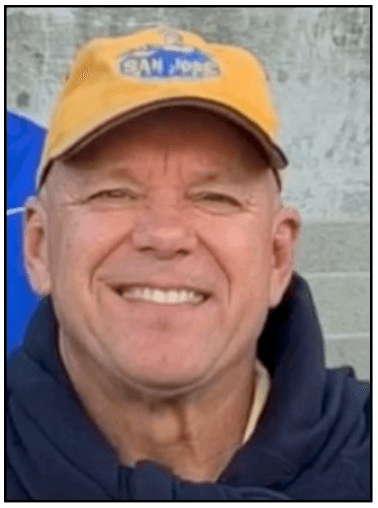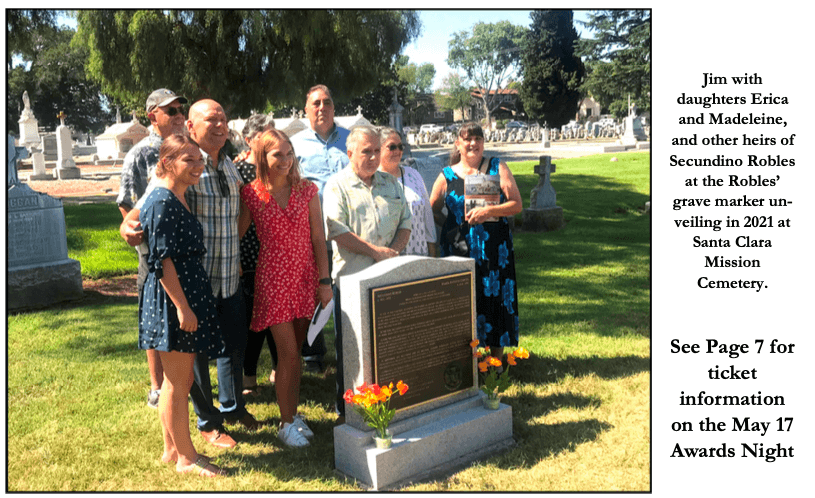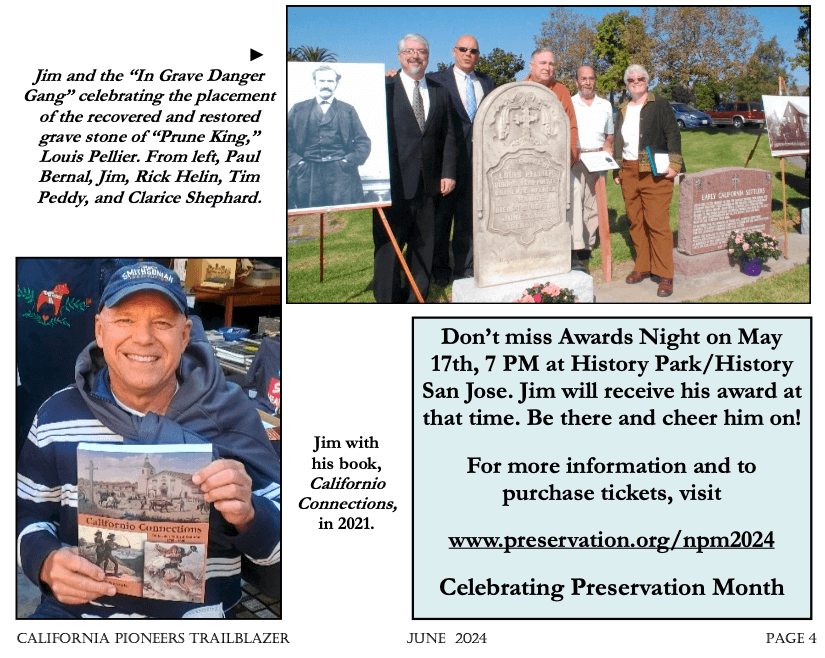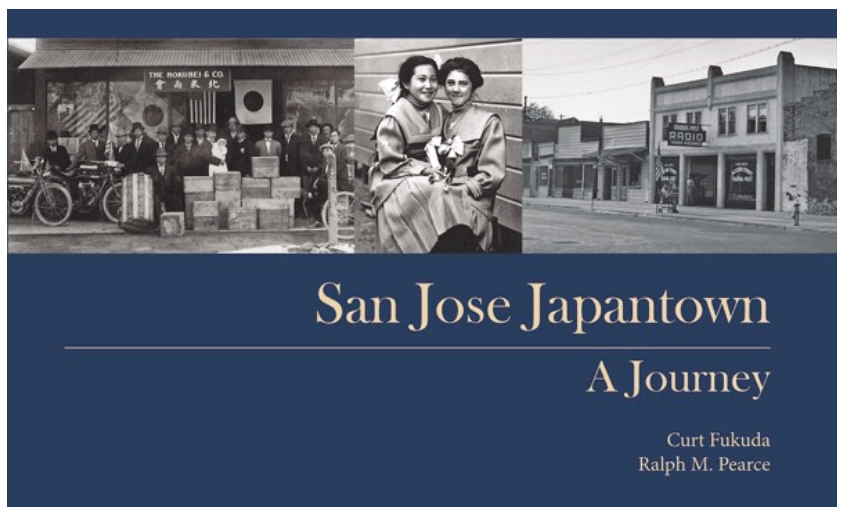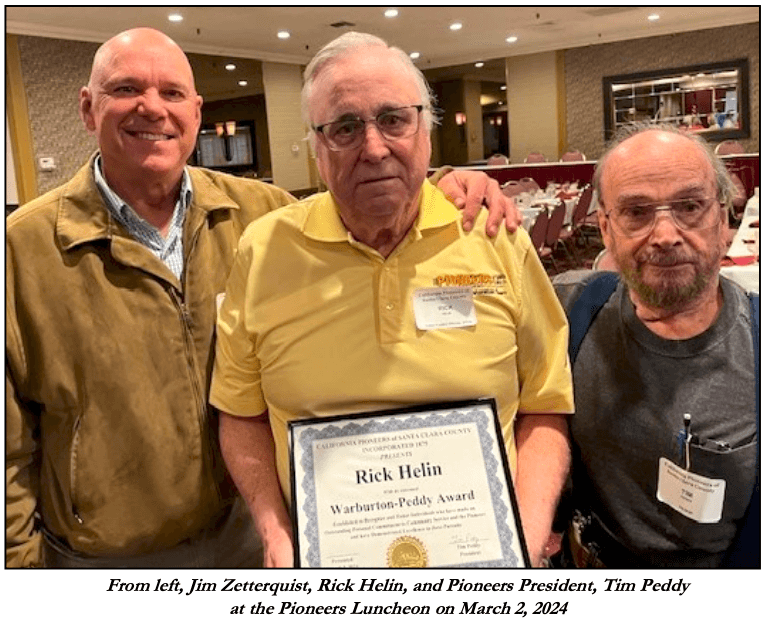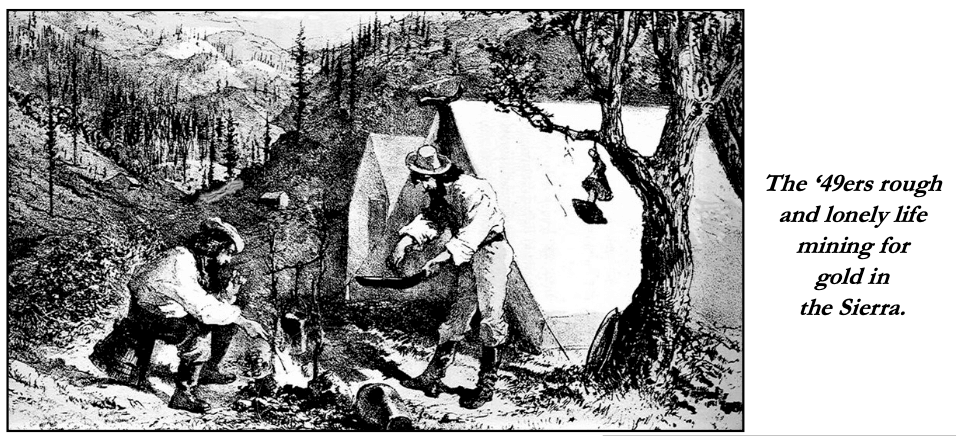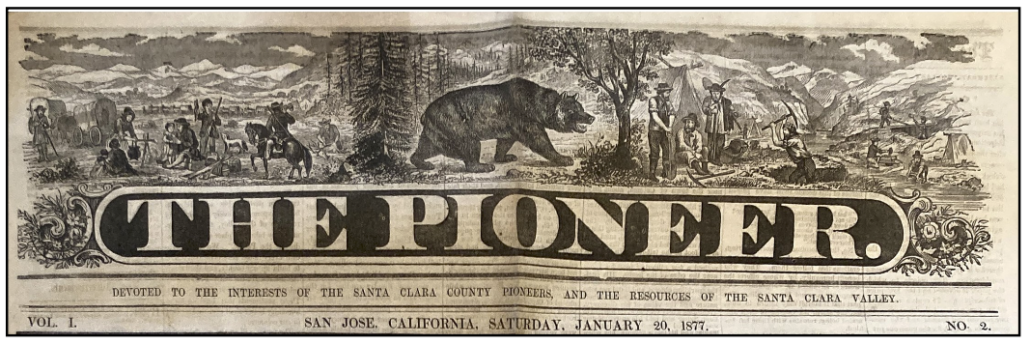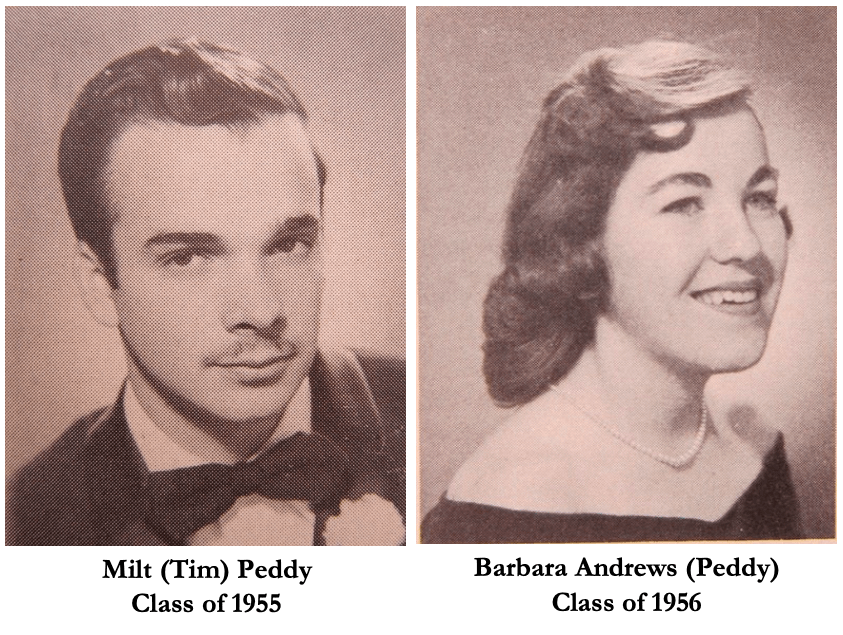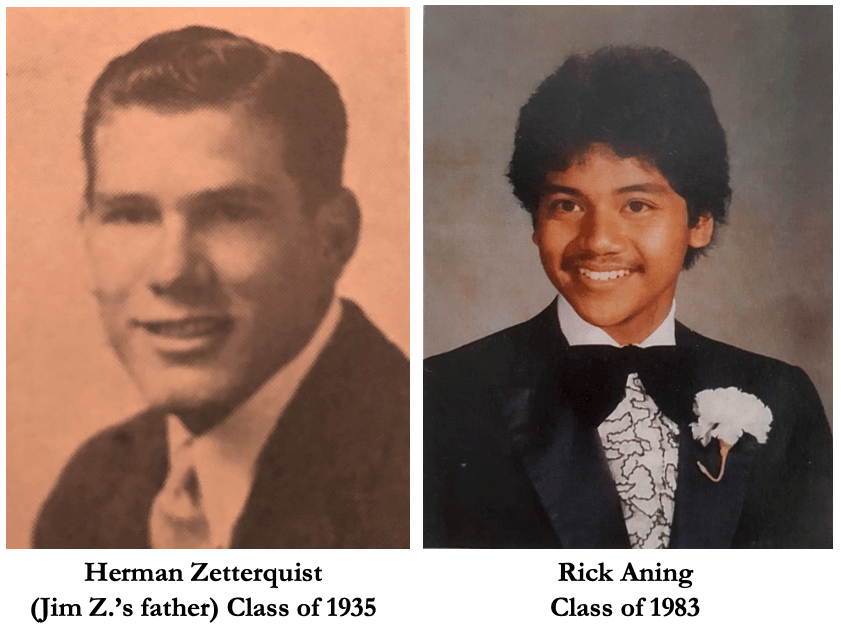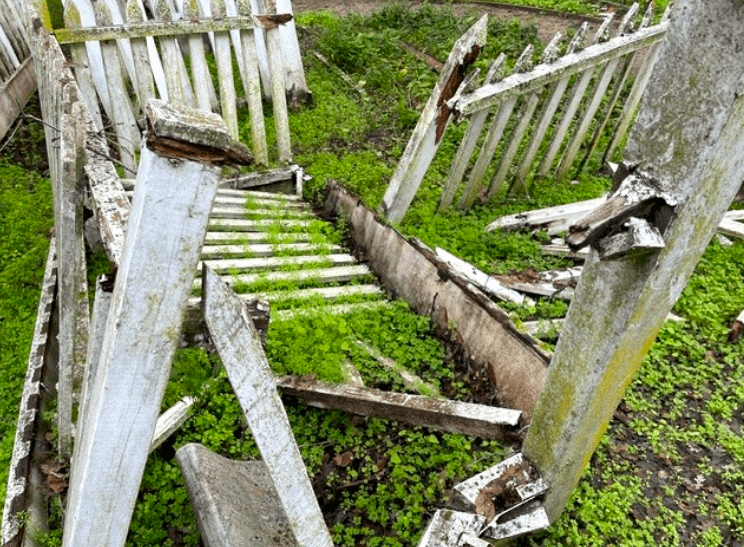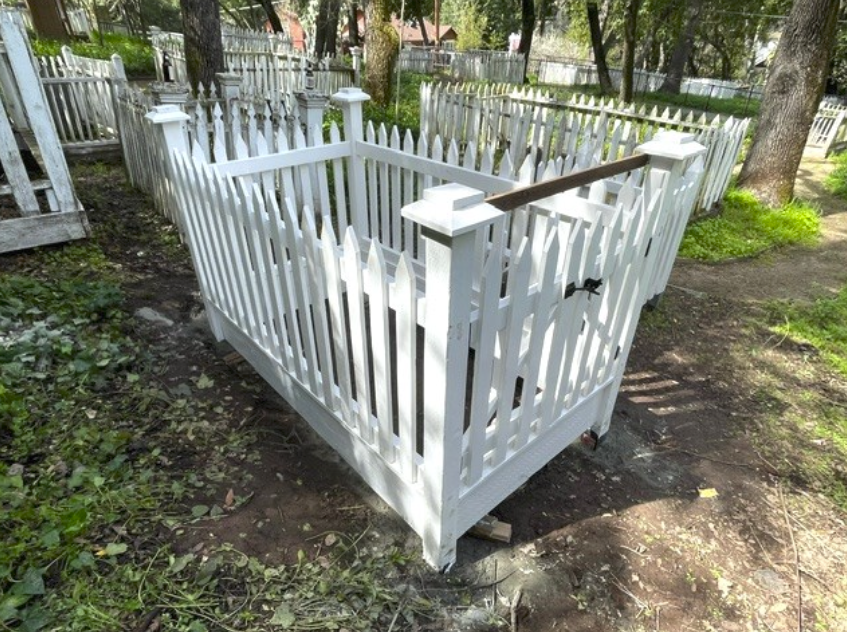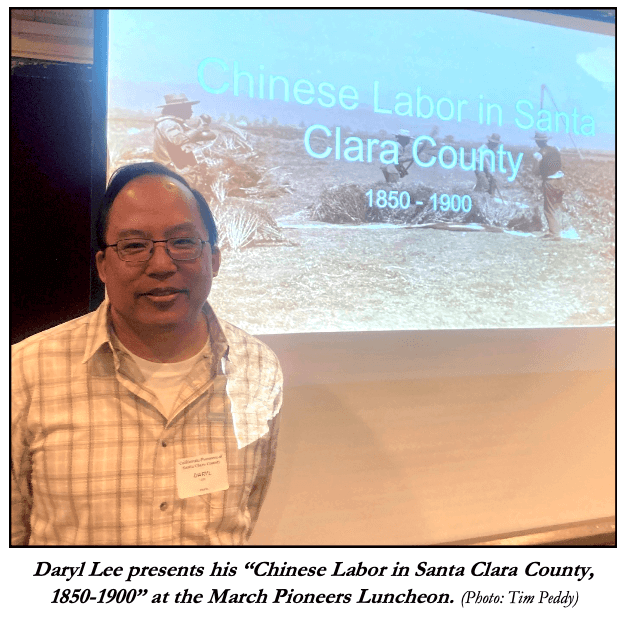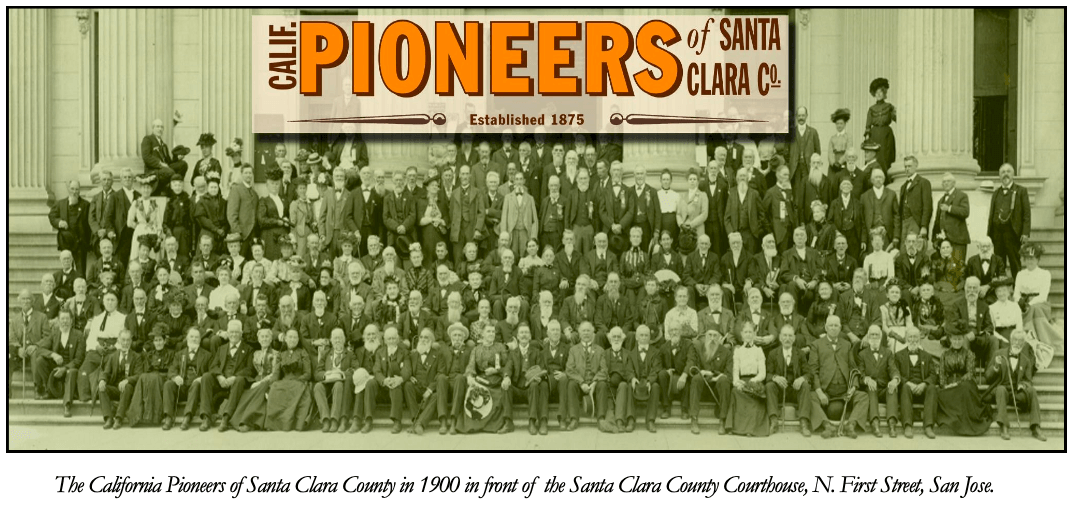Trailblazer is published quarterly by the California Pioneers of Santa Clara County Established 1875
Gayle Frank, Editor
TOPICS
Pioneers’ Preservation Award Nomination
The California Pioneers of Santa Clara County is proud to nominate Jim Zetterquist for a 2024 Preservation Award for Distinguished Lifetime Achievement in Historic Preservation, to be awarded at the Santa Clara County Preservation Alliance Awards Night on May 17th at History Park.
Jim Zetterquist, a Santa Clara County native and graduate from San Jose State University, has spent many decades of his life preserving our valley’s architectural and cultural history. Jim and his wife Lynn live in Willow Glen. Jim served on the board of the San José His- torical Museum (now History San José) in the early 1990s, and chaired its development council, which updated the museum’s master plan and oversaw its buildout. During that period, he made the furnishings for San José’s number one landmark, the Gonzales/Peralta Adobe, and built the introductory exhibit to the historic Carmel and Thomas Fallon House. He also helped found a volunteer group named “The Binford Boys,” who restored the De Luz garage at History San José, and helped with several other restoration projects at the park.
Jim joined San José’s Historic Landmark Commission in 1994, and was voted the commission’s chair three years later. In 1998, San Jose’s mayor and city council appointed him to the San Jose Planning Commission, where he advocated for historic preservation. While serving in that capacity, Jim also served as the commission’s representative on San Jose’s now defunct Redevelopment Agency’s urban design review board, where he tried to ensure all new projects were sensitive to the city’s rich historic fabric.
In the 1990s, Jim co-founded the elite Fruit Cocktail Club with Joe Melehan, an organization that for over two decades promoted the preservation of the rich agricultural heritage of the Valley of Hearts’ Delight.
In 2001, Jim served on the Board of Directors of the Preservation Action Council of San José
for 12 years, serving as its president in 2004 and 2005.
In 2007, the National Society of the Daughters of the American Revolution presented Jim with
their “Outstanding Achievement in Historic Preservation Award.”
In 2009, San Jose’s District 9 City Council Member suggested the leaders of the “We and Our Neighbors” women’s club contact Jim for advice on how to best restore their historic building for its one-hundred-year anniversary. A year later, after Jim put his talents as a craftsman and contractor to work on the building, the club’s leaders, San Jose’s mayor, and the City Council presented Jim with a commendation for his contributions, “both as a master restoration builder and as an enthusiastic educator in local San Jose History.”
In 2007, Jim became president of the California Pioneers of Santa Clara County, a position he held until 2010 and again, from 2017 to 2022! In that capacity, he advocated for the restoration of Alum Rock Park’s historic log cabin. He worked with others to receive and care for the generous donation of the Roberto Adobe and Suñol House from the Bruzzone Family. Today, these structures serve as a museum, open free to the public on Saturdays, and hosts fourth grade education programs.
In July of 2021, at the Santa Clara Mission Cemetery, Jim welcomed Robles descendants, Pioneers members, Clampers, historians and guests to celebrate the unveiling of the monument marking the grave of Jim’s ancestor–Secundino Robles (1811-1890) and his wife, Maria Antonia Garcia-Robles, whose graves were never marked with a headstone.
Jim spent decades researching his ancestor and the life around him in the Santa Clara Valley. The Robles story along with the turmoil and change of local history in the 19th century are all documented in Jim’s in-depth book, Californio Connections, published in 2021. Profits from the book go to the California Pioneers of Santa Clara County.
Today, in retirement, Jim works as one of the Valley’s oldest laborers, helping his two daughters Erica and Madeleine restore their newly acquired, ninety-eight-year-old bungalow. As Jim says, “Fruit doesn’t fall far from the tree.”
Congratulations Jim! You are so very deserving of this award for a lifetime of preserving our Santa Clara Valley history.
Pioneers Luncheon Topic: Saturday June 1st, 2024
Pioneers member Ralph Pearce will present a program on the creation of his coauthored book San Jose Japantown: A Journey, along with an overview of San Jose Japantown’s history, highlights, insights, and plenty of photos.
He also will provide an introduction to the San Jose Public Library’s California Room (state and local history), where he assists patrons conducting research.
Artifacts will be on display and the Japanese American Museum of San Jose will be on hand with copies of the 470 page, full color hardbound book available for purchase.
About Our Presenter
Lifetime Pioneers member Ralph Pearce is a third generation San Josean with a love of history. Working in the San Jose Public Library’s California Room since 2003, he authored From Asahi to Zebras: Japanese American Baseball in San Jose, California in 2005, co-authored San Jose Japantown: A Journey in 2014, and writes a popular Looking Back blog series for the California Room.
Rick Helin Receives Warburton/Peddy Award
For more than two decades, Rick Helin has been an invaluable member of the California Pioneers of Santa Clara County. He not only tirelessly served on our board for over 15 years, he acted as the Pioneers’ representative to the Sourisseau Academy for State and Local History. The mission of that organization, located in the Martin Luther King Library, is to illuminate California history through collecting materials and to prepare and disseminate historical scholar- ships to San Jose State University and the greater community. To underscore the importance of Rick’s position on that board, all we have to say is his position was previously filled by Clyde Arbuckle, Laurence E. Bulmore, and Theron Fox, three of the county’s finest late historians.
Rick’s research abilities are unmatched, and he is always willing to lend a helping hand to anyone looking for information. He is a friend to all, and his ability to retain facts, even about the most obscure subjects, has earned him the nickname “Cliff Clavin” from his fellow historians who appreciate and love him dearly.
For more than two decades, Rick Helin has been an invaluable member of the California Pioneers of Santa Clara County. He not only tirelessly served on our board for over 15 years, he acted as the Pioneers’ representative to the Sourisseau Academy for State and Local History. The mission of that organization, located in the Martin Luther King Library, is to illuminate California history through collecting materials and to prepare and disseminate historical scholar- ships to San Jose State University and the greater community. To underscore the importance of Rick’s position on that board, all we have to say is his position was previously filled by Clyde Arbuckle, Laurence E. Bulmore, and Theron Fox, three of the county’s finest late historians.
Rick’s research abilities are unmatched, and he is always willing to lend a helping hand to anyone looking for information. He is a friend to all, and his ability to retain facts, even about the most obscure subjects, has earned him the nickname “Cliff Clavin” from his fellow historians who appreciate and love him dearly.
Rick has also served on the Pioneers’ Cemetery Restoration Team and is a founding member of the “In Grave Danger Gang,” which has hunted down and reinstalled missing headstones at local cemeteries. However, Rick’s greatest contribution to our organization is the thousands of volunteer hours he has spent digitizing films for our film archive. Without Rick’s selfless efforts, we can safely say there would be no Pioneers Film Archive.
With great respect and appreciation, we are proud to present Rick Helin with the Pioneers’ highest honor, the Warburton/Peddy Award!
“When San Jose Was Young: The Pathfinder’s Victim”
This is a reprint of a 1916 series about local history written for San Jose’s Evening News and attributed to Cora Older.
“After the murder of Don José Berryessa by Fremont’s men at San Rafael, the family became known as the unhappy Berryessas. Madness, war with squatters, poverty, and bloodshed followed each other rapidly. One of the brothers, Francisco, was mortally stabbed at his house near the New Almaden mine in 1856 by a Chileno named Lanra, who was found hiding in the house under the bed of Berryessa’s sister.
In 1854, Santiago Berryessa, a brother of Don José Berryessa, was living quietly at the family adobe house on the ranch near New Almaden.
Another younger brother, Demasio, but recently married, was also a member of the family.
Like all the Spanish-Californians, the Berryessas fought continually to protect their property from squatters.
One of the squatters on the Berryessa ranch was a man named Alexander McClure. Santiago Berryessa warned McClure against building a fence on the Berryessa land. Every night McClure without fail built his fence. Every morning Berryessa destroyed it. Great was the bitterness in the heart of all Gringoes because of the murder of their brother José and their cousin, the de Horos. Santiago himself had been imprisoned by the Gringoes at San Rafael.
They, like most Spanish-Californians, believed that Gringoes were dishonest and cruel. He feared them. Berryessa warned McClure that if he built the fence again that he would kill him.
McClure did not take the warning. Santiago Berryessa shot McClure the next day. Then he went in- to the adobe house and said to his family, “I’ve shot that Gringo. I am going to Mexico for safety.
There was great commotion, and Demasio, a devoted younger brother, said, “Santiago, take my new gun. It is better than yours.”
Santiago took Demasio’s new gun, left his own worn weapon with which he had committed the murder, and never again came back to California. Demasio’s generosity caused his own death.
McClure did not appear among his friends. It was feared that he had met death in an encounter with a bear. A party was organized in San Jose to look for him. About one hundred and fifty yards from where he had been shot was found his body in a decomposed state, his breast pierced by a bullet.
It was known that there was ill-feeling between McClure and the Berryessas. The truth was suspected. A Vigilance Committee was organized in San Jose. One of the important persons connected with it was Dr. Corey, the first physician in San Jose. The committee went to the house of Berryessa in the night and charged Demasio with the crime.
He protested his innocence, but no self-respecting American ever believed a Spaniard. The Vigilance Committee searched the Berryessa house and found the gun of Santiago, who had fled to Mexico. The size of the bullet hole was precisely that of the bullet in McClure’s body.
Vainly Demasio Berryessa pleaded with the Vigilance Committee. Vainly his aged mother protested his innocence. Vainly did the young wife weep. In the night the Vigilance Committee tore young Demasio away from his family.
The representatives of law and order were on horseback, but they gave Demasio no horse. Barefoot, he was dragged over the rough road, compelled to keep pace with the horses.
Demasio’s mother who was born a Bernal, was a woman of great feeling and depth. After the Vigilantes she ran, she and Demasio’s young wife, pleading for a life of a man. All the way to San Jose the women ran, crying “Demasio is innocent. Save him!”
But the Vigilantes believed that Demasio was guilty, and they believed also, in punishing murder with murder. The Vigilantes disappeared from sight of the women, but they did not give up. They did not cease crying “Demasio is innocent!”
Demasio Berryessa had no trial. After all, he was only one of the despised, conquered race. In the night he was hanged by several men to an old live oak tree on William Street, not far from Tenth Street.
Demasio’s mother and wife wandered about the streets of San Jose calling for him, moaning that he was innocent, but not until morning did they find him. Then, so limp was he hanging from the tree that he seemed only a scarecrow of rags.
Demasio Berryessa was left hanging to the tree till his wife and his mother cut down his body. Then the mother took him in her arms, and for hours the weak woman, so strong in love, carried the heavy body of her son through the streets of San Jose “moaning and lamenting, “Demasio is innocent.”Only with difficulty was Mrs. Berryessa torn from her son’s body.
Among the Americans, the lynching of Demasio Berryessa produced great satisfaction. Justice had been satisfied. Law and order prevailed.
The oak tree where the tragedy occurred was always a trysting place for lovers. About a year ago the tree was cut down.” (in c. 1915).
—Evening News, November 3 & 4, 1916
Board Member Rod Diridon Honored
Our Pioneers Board Member, Rod Diridon, received a much-appreciated Earth Day honor, given to him by the San Francisco’s Smithsonian Affiliated Aquarium of The Bay on Earth Day, April 22 at Pier 39, San Francisco.
The Aquarium of the Bay has been open 28 years, and the Bay Institute 43 years–both operating toward missions of environmental advocacy, ocean conservation and climate resilience. They are indebted to those who have dedicated their lives to ensure that future generations benefit from policies, programs, and projects that fall within the mandate of UN Sustainable Development Goals.
The following text from the Aquarium of the Bay describes Rod’s accomplishments and the reason for this distinguished award: “We acknowledge and celebrate your tireless dedication and drive in impacting so many, that truly embodies the spirit and essence of EARTH DAY. From founding the Decision Research Institute in 1969, to the Chairmanship of the Metropolitan Transportation Commission (MTC), the Association of Bay Area Governments (ABAG), and the Bay Area Air Quality Management District (BAAQMD) to the California High Speed Rail Authority to the Mineta Transportation Institute – the journey has been both incredible and impactful at so many levels for so many. The realm of your professional accolades ranging from philanthropy to environment are truly exceptional and inspirational.
On behalf of the Board of Directors, it is our distinct privilege to confer you with the 2024 EARTH DAY Award.”
Congratulations Rod!
CA Pioneers of SCC
New Members—Welcome!
Kay Marie Gutknecht
Krista Van Laan
The Early Settlers
“They were interesting subjects—the miners of ’49. Warmhearted, generous, sympathetic, and patient, they toiled on, cheerful in their loneliness, their hearts buoyed up by happy thoughts of the good time coming, when with their pile made, they could either return to their loved ones in the East or send for them to come and join them in the Golden State. Isolated from female society and from all the charms of home, it is no wonder that whenever the spell was broken by the appearance of a woman in camp, that their enthusiasm sometimes knew no bounds, and that this parcel of femininity even though as homely as a hedge fence, was treated almost as though she were a visitor from angelic spheres. All these pioneers who worked in the gloomy canyons for months, perhaps years, in the society of men alone, will therefore appreciate the following incident which has been floating around for several years:
It was the Fourth of July, and Downieville celebrated. The Stars and Stripes floated from a peeled and lofty pine, and the house was crowded with miners. The poet, reader and orator had performed their parts, and the recently organized brass band was giving, in boisterous resonance, some national anthem, when suddenly there burst out the feeble wail of an infant; first low, then swelling out, in all the defiant strength of baby lungs. The band put forth its loudest strains; the baby, incited to renewed exertions, redoubled its vigor. It was nip and tuck between band and baby. The young mother did her best to divert the child, and hush him, when from the audience there uprose a brawny miner, who, shaking his fist at the music, cried, “Hush that infernal band, and give the baby a chance!” The band ceased its playing, and never did stalwart men listen to sweeter music than did those exiles from home and women, as they drank in the tones of that wailing child. The child was hushed upon its mother’s breast, and at the word there went up three rousing cheers for the first baby of the northern Sierra.”
From the The Pioneer —Jan. 20, 1877
What Are the Pioneer Papers?
Some of our members and other local residents have wondered, “What are the Pioneer Papers?” They were a weekly, local newspaper beginning in 1877. Here is the mission of THE PIONEER newspaper in the publisher’s own words.
Prospectus
“Believing that the welfare of those who, in the early history of our State, battled against the many vicissitudes that contended against the opening of this garden spot of the world, California and civilization, would be served by the publication of an organ devoted exclusively to their interests, and to the resources of the Santa Clara Valley. The publisher of THE PIONEER has thought best to issue a weekly newspaper with that object, the first number appearing on Saturday January 13th, 1877.
The paper will contain nothing sectarian or partisan, but will strive to be the exponent of every industry and resource of the valley that has permanently taken its place as the “Paradise of the Pacific.” We shall advocate every noble enterprise that tends to build up our county, and
shall make the interests of the early Pioneers the subject of our most earnest solicitude. Those sentiments that tend to make humanity better shall ever find a place in our columns. The paper will be the official organ of the SANTA CLARA COUNTY PIONEER SOCIETY. And, as such organ will contain a full list of all its members, together with their post office address and the year of arrival, the Constitution, By-Laws, and list of officers. Each issue will contain a sketch of the life and adventures of one or more of its members, and will also contain full and correct reports of all the meetings of that Society.
The paper will each week contain all the items of interest transpiring through the county, together with well-prepared editorials on different subjects of interest to the pioneer, the merchant, the farmer, the laborer, the mechanic, the capitalist, and all other classes of the community; also items of the days of auld lang syne that have nearly been forgotten, will be republished, which will make the paper interesting alike to all.
The PIONEER has entered a field preeminently its own, and will be the opponent of no journal on the Coast. To it’s contemporaries it will ever be ready to extend a helping hand in the great work of social improvement, and would ask of them the courtesies of the profession.
As an advertising medium THE PIONEER will be found one of the best in the county, as it finds its way into the home of its patrons, to be read and re-read by every member of the family.
The attention of our businessmen and the advertising public is called to this fact.
It shall be the aim of the publisher to make THE PIONEER a welcome visitor to the home of all.
The subscription price has been fixed at the very low price of $2.50 a year, by mail, postage paid, or delivered by carriers in San Jose at 25 cents per month. This price is within the reach of all and will ensure THE PIONEER a large circulation. SUBSCRIBE FOR IT.
Very respectfully,
Alex. P. Murgotten, Publisher
From the The Pioneer
Jan. 20, 1877
Editor’s Note:
Alex Murgotten was a founding member of the Santa Clara County Pioneer Society (now called the California Pioneers of Santa Clara County), established in 1875. When this issue (Vol. I, No. 2) was printed and delivered, the newspaper had 1,500 subscribers, way beyond the publisher’s expectations!
Perusing SJ High Yearbooks
High School yearbooks can be fun to look at years later. Pioneers member Rick Aning sent us a few graduate photos who are Pioneers members or related to a member. You might recognize somebody, or not! You most likely will see three of these graduates at our next luncheon in June.
Rick says, “Referring back to the previous issue of the Trailblazer dated March 2024, there were some names of individuals mentioned in the San Jose High Alumni article that are also California Pioneers of Santa Clara County. Go San Jose High School Bulldog Alumni!
New Crib for Hacienda Cemetery Crypt
Some of the cribs at the Hacienda Cemetery in New Almaden are deteriorating over the decades. In March, 2024, volunteers Bruce Bartlett, Mike Boulland, Ron Iota, and Cal Iantrip completed the rebuild and installation of the crib for the D. C. Gibson crypt marked 1893.
Photo to the right shows the damaged crypt. Below, the crib is beautifully in place.
The Pioneers thank you for your hard work and care of the Hacienda Cemetery.
Highlights from March Luncheon Presentation
Our March 2nd Luncheon presentation by Daryl Lee was a great success. Guests enjoyed the event, asked questions, and commented at the end. Daryl has given us a brief summary of the important points of the presentation below. Thank you, Daryl!
Thank you Daryl, for a very enjoyable presentation! ❖
What’s New at History Park?
On April 16th, History San Jose’s Ken Middlebrook and CEO Bill Schroh announced that the museum has entered into a unique relationship with news radio station KCBS, who will be broadcasting live on a daily basis from the lobby of the Pacific Hotel. History
Park is located at 1650 Senter Road, San Jose.
While currently based in San Francisco, the station began in San Jose in 1909—the first regularly broadcasted radio station in the country! In a sense, the station has returned to its roots.
June 1st Luncheon
Annual Meeting & Election
The California Pioneers of Santa Clara County Annual Meeting and Board of Directors election shall take place at the June 1st Luncheon. The slate will include half of our Board Members whose terms are up as required by our Bylaws and Policies.
The Board Members up for election for a two-year term (2024-2026) are: Paul Bernal, Rachel Fischer, Bill Foley, Gayle Frank, Veronica Jordan, Ken Machado, Mike Sanchez, and Jim Zetterquist.
The brief Annual Meeting will also include the presentation of the annual fiscal report. If a member would like a copy of the report, contact us.
Be Part of Our 150th Anniversary Bash
The California Pioneers of Santa Clara County will be celebrating 150 years in 2025! We are one of the two oldest pioneer societies in California. Would you like to participate on the Sesquicentennial Celebration Committee and offer ideas for such a notable event? If so, please email President Tim Peddy
Yes, the Pioneers organization was founded in 1875 so we’ve been around a long time. What is the best way to celebrate this distinguished accomplishment? Give us your ideas, input, and volunteer to participate in this celebratory event next year ❖
Is Your Address Correct on Trailblazer
Because we experienced some problems with the delivery of our Trailblazer newsletter, we have just finished an audit of all our Life Members.
Thanks to all of you who responded with name or address corrections. We appreciate your tolerance of our past mistakes. This should help us to get the Trailblazer to you.
If you did not get an audit letter from us, do not fear. It simply means that I already had the information needed.
If any members, Lifetime or Yearly, find there are still errors in your name or address, please reach out with corrections.
If you would prefer to receive your Trailblazer by email only, notify Gayle Frank
Thank you,
Tudy Johnson, Membership Chair
Membership
The membership dues for the California Pioneers of Santa Clara County are always due on January 1st every year. Basic dues are still only $35 ($60 for family).
If not already paid, please pay your member- ship renewal for 2024 now. Dues can be paid online (see page 10) or mailed to CA Pioneers of SCC, Membership Chair, P.O. Box 8208, San Jose, CA, 95155. Or—renew easily at our next Luncheon (see page 2).
Check your mailing label on your Trailblazer and it will indicate when your dues expire. For example, if after your name it says, Dec-2023, your Pioneers membership has expired.
Additional donations or higher membership levels are always appreciated. CLICK HERE for more info. And please, don’t forget the Pioneers in your estate planning and consider donating from your IRA’s required minimum distribution to lower your taxes. ❖
For Questions Contact our Membership Chair
Time Travel (Past News from Newspaper Archives)
San Jose, Jan. 1880: The Oak Hill City Cemetery Committee was instructed to install 50 hitching posts and the planting of 50 trees within the cemetery property.
Los Gatos, Feb. 1895: Because of a recent anti-noise town ordinance, the Salvation Army was denied the use of their familiar drum and tambourines for their nightly parades. Undaunted, the dutiful group continued to march, but only to the time of subdued hand clapping.
San Jose, Jan. 1902: The Standard Electric Co. was preparing to extend its power as far south as Los Gatos and Gilroy. Officials said the pretentious project would include artistic poles through each town along the route. It was also their belief electricity could be utilized for a variety of purposes among the homes of the better class.
San Jose, April 1905: The directors of the Mt. Hamilton Exploitation Co. met for the purpose of discussing plans relative to the proposed electric railway to Lick Observatory. The directors present being Major Chas. P. Braslan, Henry Doerr, T. S. Montgomery, John Bennett, T. C. Barnett, and V. A. Scheller. The daring scheme, which eventually perished, was to consist of two overhead monorails for safety, with planned speeds up to 200 miles per hour.
Santa Clara, May 1911: Postmaster E. M. Don received word that free house to house mail delivery would begin June 15, 1911. Three mail carriers and one substitute carrier would make up the force. Twenty mailboxes through the city were anticipated.
San Jose, March 1913: Fifty miles of asphalt from San Francisco to San Jose was planned. According to the State Highway Commission the boulevard would be 40 feet wide and the same as a city street with concrete and asphalt surface. This promised to virtually bring every home in the peninsula within easy motoring distance to San Francisco. ❖
Pioneers Gone to the Golden Hills
Vanley Batchelor
Margaret ( Margie) Heath
Betty Jeanne Johnson
Tom Pace
Terry Wallen
June Winslow

